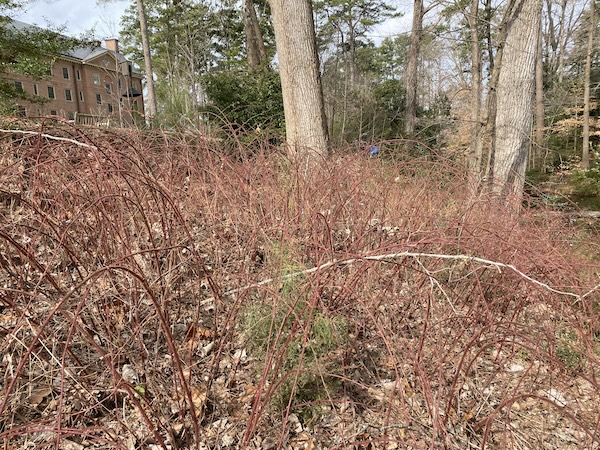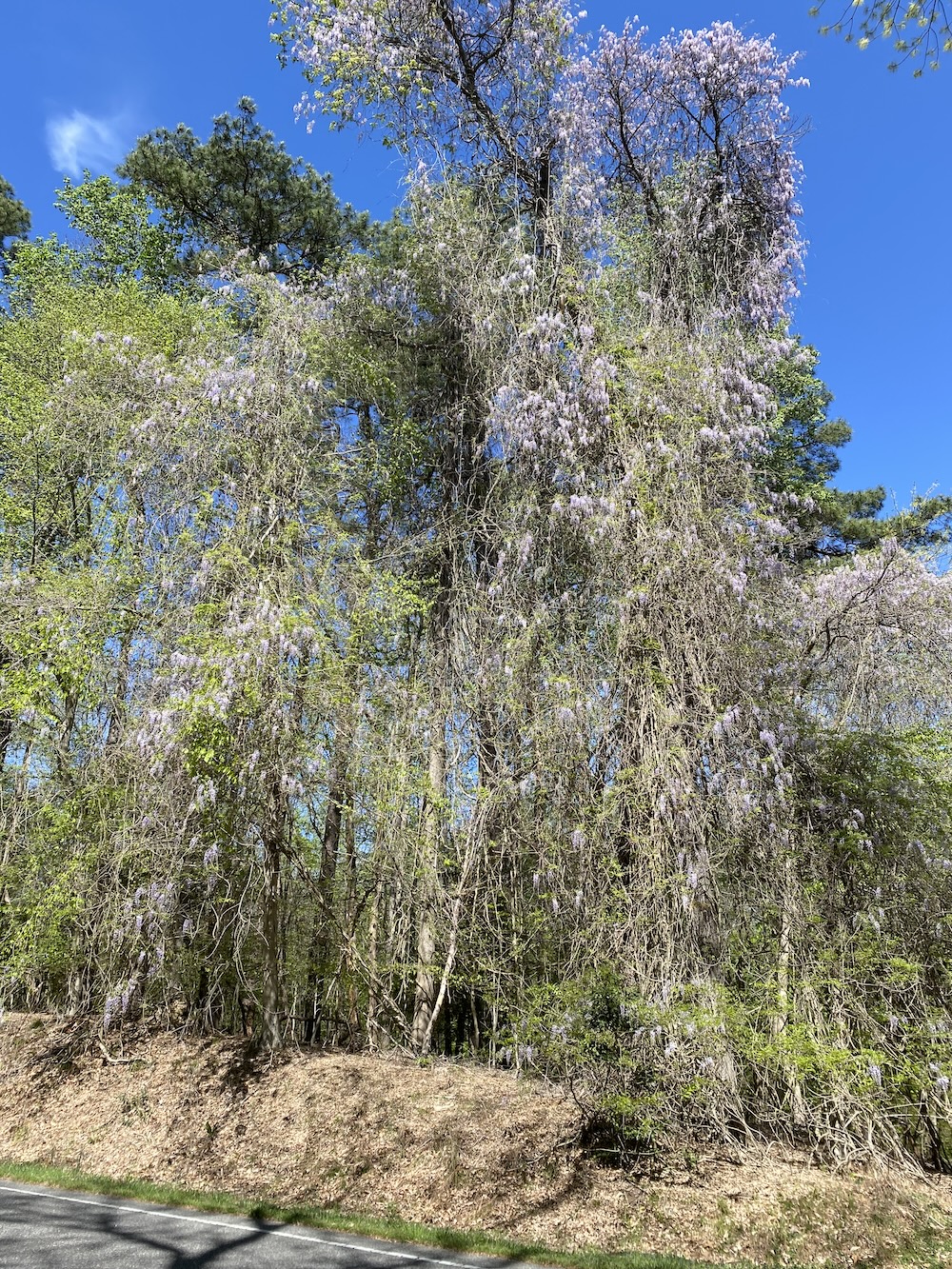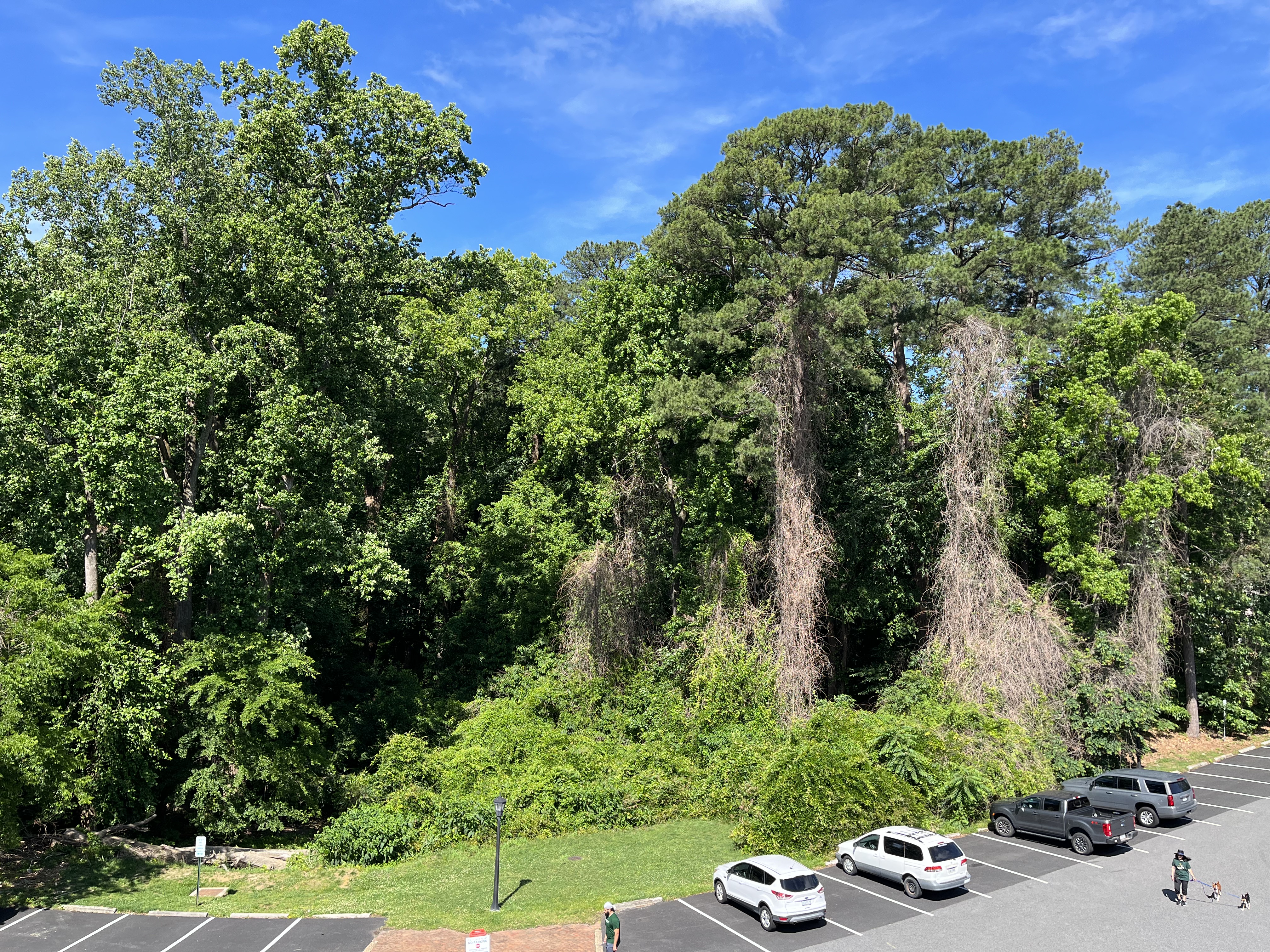Restoring Williamsburg’s woods, one plant at a time
Tracy Matthew Melton ’85, P ’20 on removing invasive species from campus and beyond
August 28, 2024
By
Tracy Matthew Melton ’85, P ’20
I’m a historian by trade; writing is my passion. My wife, Pam Krulitz ’86, and I lived for more than two decades in Oakton, Virginia, and were fortunate to have some surrounding woods. I spent almost no time in them and did little gardening or landscaping, beyond planting invasive Japanese barberry (Berberis thunbergii). I did enjoy walking in the nearby woods on the Gerry Connolly Cross County Trail, although I’m not sure that I could have identified one tree beyond “That’s a pine” or “That might be an oak.”
Over the last five years, though, I’ve spent more than 2,000 hours in the woods removing a range of invasive plant species in Williamsburg where we now live. A former Oakton neighbor, Sarah A. Holtz ’94, often posts on social media about invasive removal projects that she organizes in the Difficult Run Stream Valley in Northern Virginia. Her posts informed me that the plants behind our Williamsburg house included autumn olive shrubs (Elaeagnus umbellata), Japanese honeysuckle vines (Lonicera japonica) and Japanese stiltgrass (Microstegium vimineum) — all invasive species.
By invasive, I mean that they are nonnative species that often outcompete native ones, causing environmental and economic damage. The environmental damage can be direct, like autumn olives outgrowing and physically overwhelming native shrubs and seedlings, or more complex, like those same autumn olives not serving as a host plant to native caterpillars, resulting in a decline in caterpillars and the birds that eat them. Even soil chemistry may be negatively impacted by invasive plants.
On walks, I started to notice enormous numbers of Japanese honeysuckle vines wrapping and strangling small trees on the W&M campus, especially along the wooded paths through the Wildflower Refuge. My initial thought was that the natural spaces contribute significantly to the beauty of the campus, a crucial aspect of the university’s appeal. If the natural spaces were lost, it would be harmful to the community and the institution. Imagine the diminished vista across the Sunken Garden from the Wren Building without the woods surrounding Crim Dell.
Only later did my perspective broaden to consider the far-reaching importance of these woodlands to the health of the local, regional and even faraway environments.

A few years ago, I contacted Calandra Waters Lake, then the W&M director of sustainability, now the executive director of Wild Virginia. She put me in touch with Linda Morse, a W&M geology professor who heads a master naturalist program for students and an invasive removal project on campus. I started to work with Morse, her students and other master naturalists removing invasives. We coordinate with Tony Orband, the W&M associate director of grounds & gardens, and have now removed many thousands of invasive plants on campus, most notably honeysuckle, autumn olive, wineberry (Rubus phoenicolasius), mahonia (Berberis japonica), Chinese holly (Ilex cornuta), Chinese privet (Ligustrum sinense) and Chinese wisteria (Wisteria sinensis).
I also started to work with neighbors in our shared woods and the five ravines that cut through the neighborhood down to the historic and environmentally-critical College Creek, only a mile or so from Colonial Williamsburg. These woods had been (and still are) heavily infested with the invasive tree of heaven (Ailanthus altissima). Tree of heaven is rapidly becoming a ubiquitous sight along roadways across the region and is extremely destructive to native woods.
A few examples demonstrate the dramatic, existential impact that invasive plants are having on woods in Williamsburg. Several thousand hairy, red wineberry canes were crowding closely together at the east end of W&M’s iconic Crim Dell. Wisteria had a significant foothold on either side of the dell. Imagine the Crim Dell bridge framed by dying trees and sprawling vines.
Thousands of wisteria vines had killed almost every plant in the woods across from the Alumni House, including several mature trees. A forest was simply disappearing.
On the far west side of campus, W&M owns 5 wooded acres on the northeast side of Compton Drive and the 501-acre College Woods on the southwest side. These woods provide critical habitat for regional wildlife. Yet wisteria had apparently taken root in the woods on the northeast side and later jumped Compton into College Woods, where it was also well established.

Someone driving down Compton Drive in April may have noticed the vine’s purple flowers high up in the treetops. In winter, if observant, they may have noted a couple of trees overtopped or wrapped in heavy vines. The reality, though, was a vast area networked with thick roots and runners, with almost every tree and shrub wrapped or surrounded by wisteria and on a fatal course. Eventually, almost nothing above ground survives wisteria. These beautiful purple flowers are the engaging smile of a relentlessly destructive monster.
This spring, Keith Navia ’78 and I removed at least 1,500 wisteria seedlings around one shallow ravine adjacent to Compton, one of four areas infested in these woods. That was after we had cut almost every large vine earlier the previous spring, pulled up the vast majority of roots and runners and cut back regrowth.
We have pulled up and cut down over 1,000 small trees of heaven and well over 50 large ones, on just a few acres of neighborhood common land along South Henry Street, directly across from the Eastern State Hospital Cemetery. We have removed even more Chinese privets, many thousands of Japanese honeysuckle shoots and hundreds of misshapen, sprawling autumn olives, too. Imagine driving into Colonial Williamsburg and not passing the traditional forests of familiar pines, oaks, hickories and beeches but instead a tangle of unproductive, unchecked escapees from well-intended landscaping projects.
All of this work, on campus and on common land, has been accomplished with only gloves, hand pruners, loppers, a folding pruning saw and occasionally a shovel to get up tree of heaven roots. A lot can be done with the simplest tools.
Getting into the woods has provided me with a new perspective. I look at our woodlands differently as I drive around the region. In the spring and summer, there are Callery pear trees (Pyrus calleryana) blooming white along tree lines adjacent to regional roadways, then wisteria and princess (or empress) trees (Paulownia tomentosa) blooming purple, followed by mimosa trees (Albizia julibrissin) blooming pink and trees of heaven laden with tens of thousands of seeds in yellow or orange, even blood orange, clusters. These are bright indicators of an otherwise stealthy process of the underlying damage.
I feel more hope than pessimism, though. It is human and healthy to work in nature. It is grounding. I have much to learn but can now identify many of the plants in our Williamsburg woods, the healthy and the unhealthy. I see lots of wildlife. I’ve met numerous people working hard to protect our natural spaces. Collaboration is also human and healthy and uplifting. I feel extremely appreciative that the W&M community has contributed to my evolution.
Most importantly, environmental healing is underway. Native pawpaw trees are already proliferating in woods where wisteria and Japanese honeysuckle have been removed.
While doing this work, I came to realize that our yard was planted with several invasive plants, including Chinese hollies and privets. I have replaced those with native plants, many of them beneficial to pollinators.

In fact, our own yards are a great place to start doing what we can to save our natural world. After all, we collectively own much of the land. Plant native, remove invasive. That can be difficult as many plants available for sale are nonnative and invasive. A quick internet search, though, can provide a wealth of information about a plant. Is it native or nonnative? Is it invasive? If nonnative, is there a comparable native? In Virginia, the Department of Conservation and Recreation (DCR) publishes a list of invasive plants. The Virginia Native Plant Society offers several resources to help people find appropriate native plants and good substitutes for nonnative ones. If demand for native plants increases, supply will follow. That seems to be happening already, but too slowly.
There are many great ways to get more involved. Many states have master naturalist volunteer programs. Master gardening and native plant organizations are doing important work, as is Blue Ridge PRISM, which focuses on invasive plants. Knowledge and experience are not necessary, just a little passion. I could hardly identify any plant when I started. I was moderately fit and beyond young. Now, I know the woods well. I work in them at least a few days almost every week. I’m making a small but impactful contribution. Collectively, so much more can be accomplished, often just outside our windows.
This work doesn’t solve all of our problems. But it’s something that can be done. It’s a start. Imagine that.